American Bonsai at the NC Arboretum
+95
kingsnake
Tom
MKBonsai
BrianS
manumidam
Chris Cochrane
Intricate Simplicity
chench53
KyleT
Maros Belan
DjTommy
Bolero
Gonetopot
Rick36
M. Frary
Van
Toshiro
fiona
Precarious
drbuzzbee
geo
LanceMac10
MichaelS
kimo
Chellis
Leo Schordje
FrankP999
dick benbow
BrianG
crust
TN Jim
Seth Ellwood
Wander
peterkang
Judgie
Kevin S - Wisco Bonsai
Vance Wood
JMcCoy
brett2013
GerhardGerber
lordy
Eric Group
my nellie
steveb
Jaybird
Todd Ellis
jgeanangel
Daygan
AlainK
Richard S
Randy_Davis
Robert J. Baran
David Brunner
William N. Valavanis
Jkd2572
Dale Cochoy
Jesse McMahon
prestontolbert
yamasuri
bingregory
Stephen Krall
DougB
Ashiod
JADunnagan
sayotefries
JudyB
Dan W.
Khaimraj Seepersad
DuncanJH
Dave Murphy
monte
MikeG
augustine
Russell Coker
Kev Bailey
lennard
BigDave
Marty Weiser
Smithy
coh
tmmason10
dorothy7774
gman
Dave Leppo
hometeamrocker
bwaynef
Billy M. Rhodes
Walter Pall
Sam Ogranaja
JimLewis
MartinSweeney
bonsaisr
Auballagh
John Quinn
Arthur Joura
99 posters
Page 5 of 40
Page 5 of 40 •  1, 2, 3, 4, 5, 6 ... 22 ... 40
1, 2, 3, 4, 5, 6 ... 22 ... 40 
 Re: American Bonsai at the NC Arboretum
Re: American Bonsai at the NC Arboretum
Arthur,
very refreshing!
Presently we are just rain, and it is very cool as the temperature goes, so I am loving it.
In a few weeks our Immortelles will drop all of their leaves and go into bloom, a vivid orange
and a mild yellow. Then many other trees will follow.
It was amazing to see the maple leaves with the stone.
Thank you very much.
Khaimraj
very refreshing!
Presently we are just rain, and it is very cool as the temperature goes, so I am loving it.
In a few weeks our Immortelles will drop all of their leaves and go into bloom, a vivid orange
and a mild yellow. Then many other trees will follow.
It was amazing to see the maple leaves with the stone.
Thank you very much.
Khaimraj
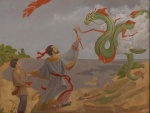
Khaimraj Seepersad- Member
 Re: American Bonsai at the NC Arboretum
Re: American Bonsai at the NC Arboretum
What a beautiful place! So well kept. Thanks for the pictures.Arthur Joura wrote:..
Here is a sampling of images made in the Bonsai Exhibition Garden over the last 4 weeks..
Best,
Dorothy
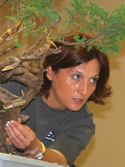
dorothy7774- Member
 Autumn Review, part 3
Autumn Review, part 3
Kaimraj, Jim, Dorothy and Jeremy - Thank you for continuing to follow this thread and posting your responses!
I mentioned earlier that this autumn season was not as brilliant as some others of recent years in this part of the world, and such is the truth. I hesitate to make that comment because there have been some years where the leaf color seemed wonderful to me, but I would encounter individuals who held that it was less so, and they would use the same language to express their disappointment - "The colors are not as good this year..."
Certainly, to some extent every thing we look at we see subjectively, so our moods and expectations and the natural enhancements of our memories may color the scene before our eyes every bit as much as does the change of the season. We are also, I think, prejudiced in our perceptions of such effects as autumn coloration by the influence of photography, and to a lesser extent, other pictorial representations. These manipulated images give us an idealized view that reality is usually hard pressed to equal. Still, there are years when the scenery is more colorful and years when it is less so, and this year was not outstanding.
I have read some opinions that years of abundant or excessive rainfall can adversely affect autumnal leaf coloration, and North Carolina experienced abnormally wet conditions through most of the year, so perhaps that was at play. There was also a sudden and dramatic drop in temperature a couple of nights late in October, where temperatures went from being in the upper 40's and low 50's (Fahrenheit) to the low 30's and upper 20's, and this had a noticeably detrimental effect on many plants just on the verge of changing colors. Several bonsai in the Arboretum's collection were high profile examples of this.
Our Ginkgo (Ginkgo biloba), which usually spends a week showing off like this:

instead this year had this appearance:

And our Natchez Crape Myrtle (Lagerstroemia X 'Natchez'), which usually shines like this:

turned up one morning sulking like this:
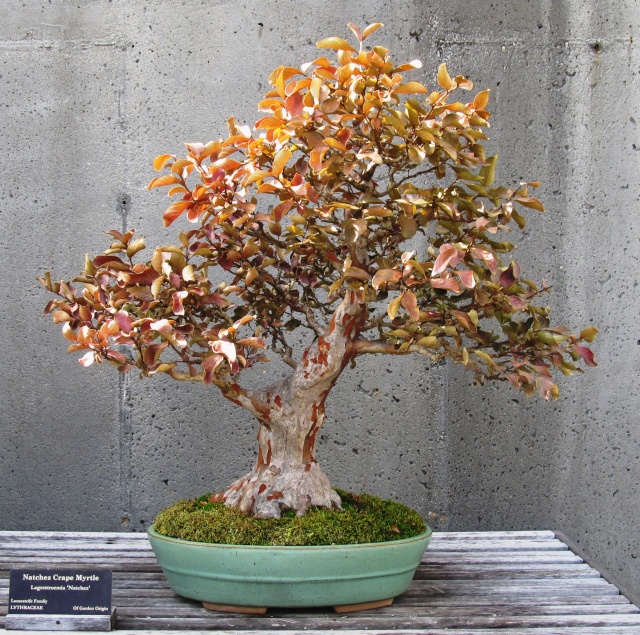
Hard to argue that these trees did not show better last year than this! Even among those specimens that were not directly zapped by the freeze and heavy frost, the overall coloration was duller, largely favoring muted yellows over the more showy reds. Comparisons aside, however, we still had an overall attractive autumn season. Here are some selections of pieces as they appeared on display in the Bonsai Exhibition Garden during the last part of October and the early part of November:
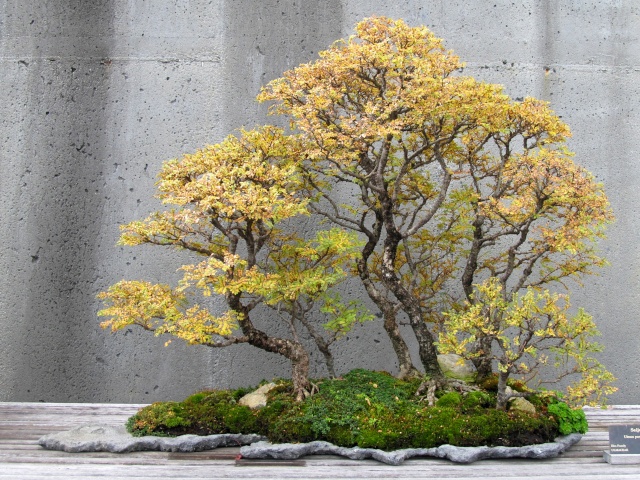

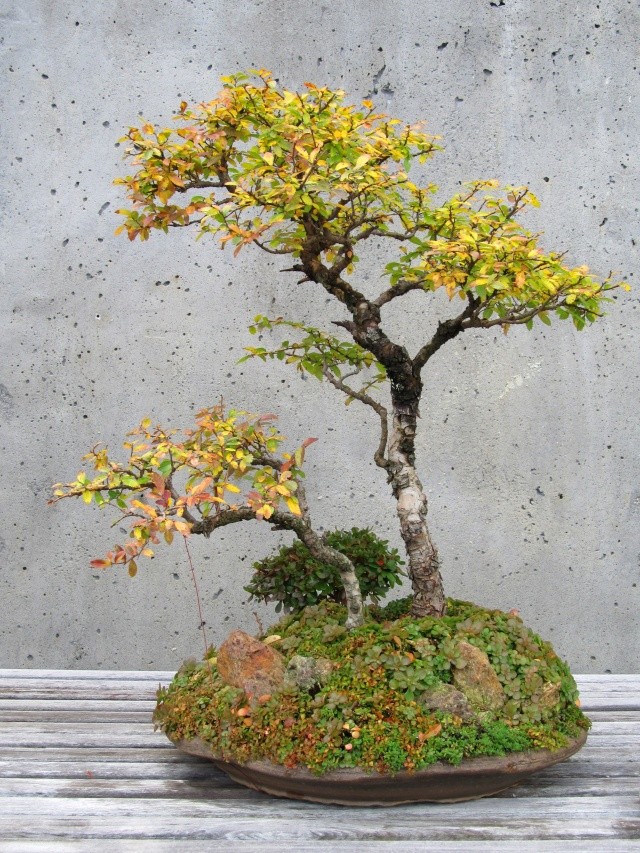


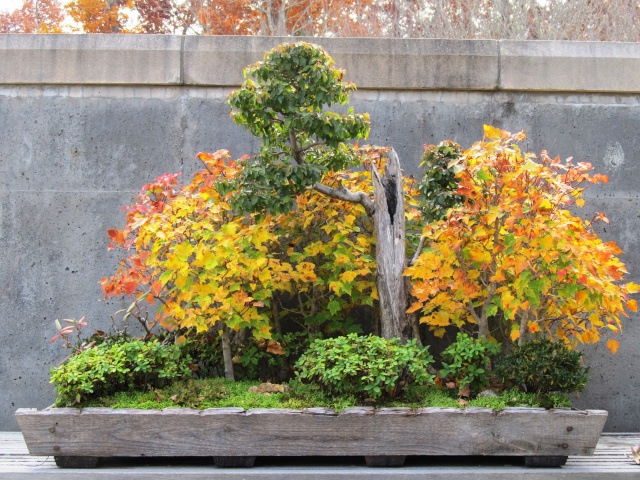
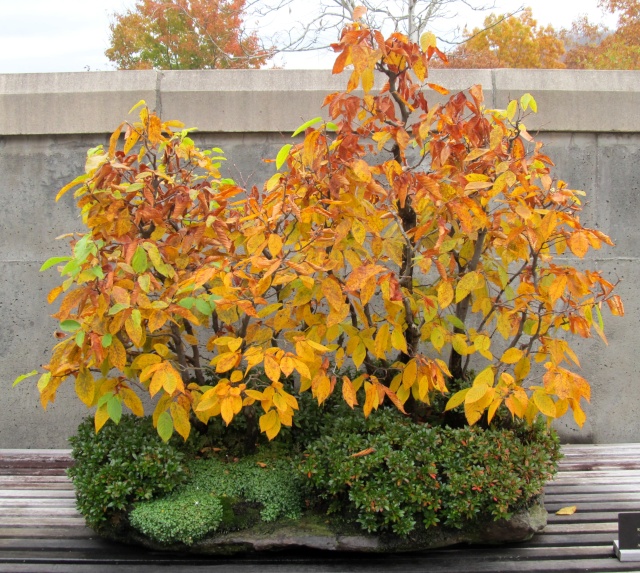
Worth noting, 2 specimens in particular had outstanding color this year, as good as they ever have had. The first is a Tamarack (Larix laricina) and the second is Amur Maple (Acer ginnala):
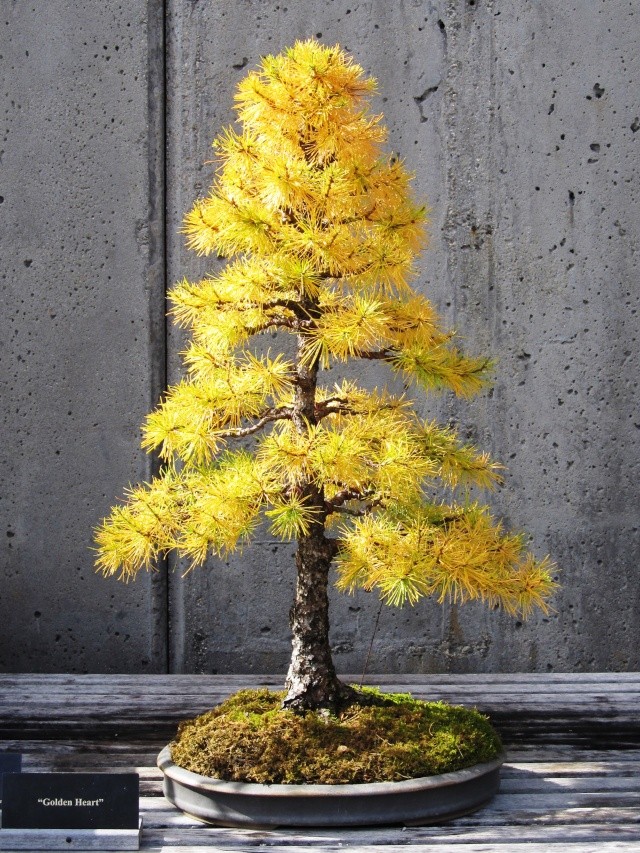

Is it merely a coincidence that both these species originated in parts of the world much colder than we typically experience in western NC?
The Arboretum's collection includes many more specimens than we have room to exhibit in the garden, and some of these other bonsai presented respectfully this autumn.
Allegheny Serviceberry (Amelanchier laevis):
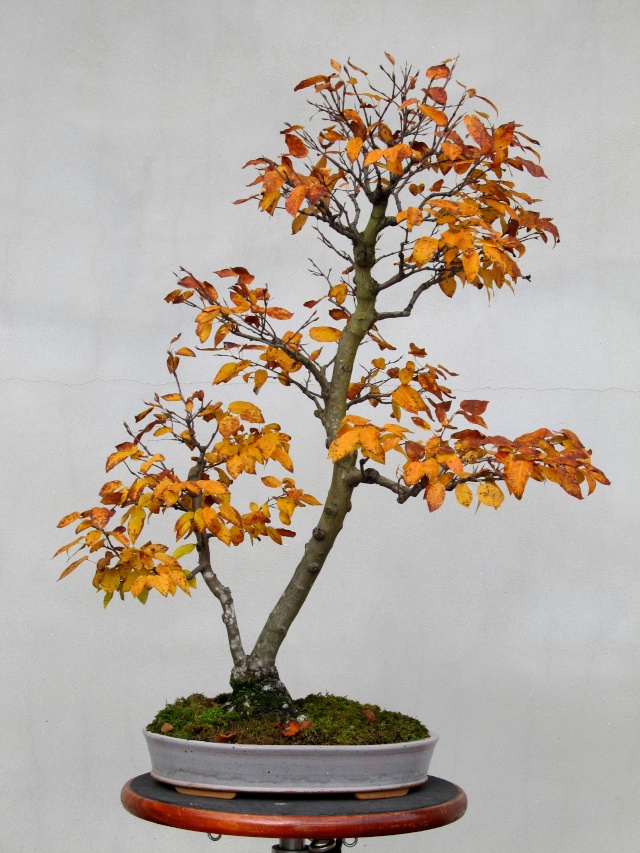
Winged Elm (Ulmus alata):

Witch Alder (Fothergilla major):

To conclude this autumn rumination, I offer this image of a Mountain Dwarfdandelion (Krigia montana) and a few accompanying thoughts:
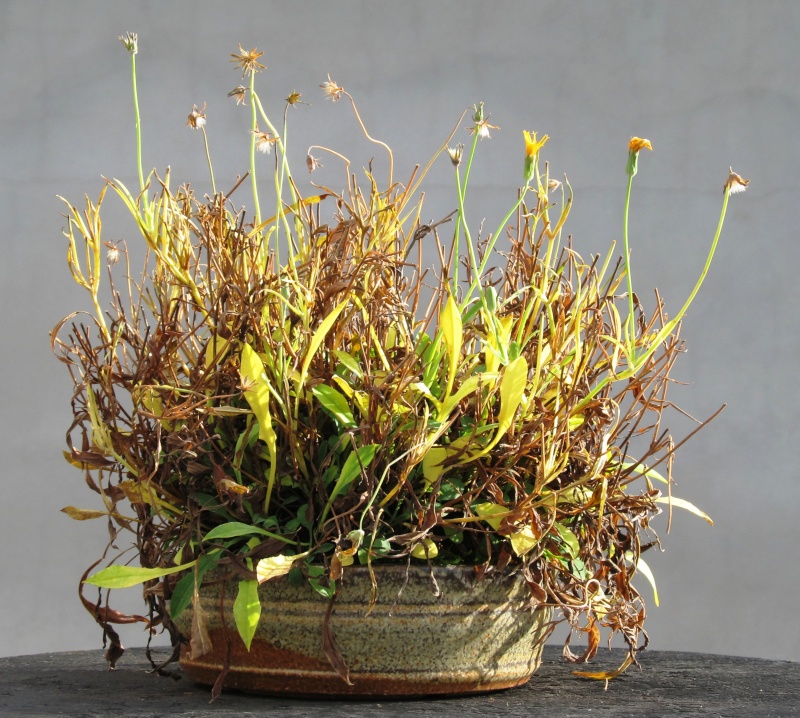
Autumn, like spring, is a transitional season, a bridge between the two other, more substantial seasons, and all four together make up a full rotation around the sun in the temperate places on earth. The two transitional seasons spend a fair amount of their allotted time mimicking the seasons that precede and follow them, so that the beginning of autumn feels very much like summer and the last part of autumn can be as bitter as winter. In our idealized vision of "Autumn", the deciduous trees are ablaze in the glories of that spectrum of the rainbow that covers everything from the coolest of yellows to the warmest of reds, and the air is a pleasing combination of the best attributes of both warm and cool. Yet the bulk of the time in that particular season is otherwise. The brightest colors show themselves for only a few weeks before continuing inexorably to the dullness of decay, and the mildest of days occupy only a short path between an expanse of heat on one side and an expanse of cold on the other. It is the ephemeral nature of autumn and spring that endears them to those of us who experience them. They come, and then before you know it, they are gone.
At the end of spring, a person looks ahead to the promise of a long season of growth and life.
At the end of autumn, there is not so much to which we look forward as there is that which we look back upon.
As such, a person in autumn is well served to remember that life is cyclical, and is forever going around!
I mentioned earlier that this autumn season was not as brilliant as some others of recent years in this part of the world, and such is the truth. I hesitate to make that comment because there have been some years where the leaf color seemed wonderful to me, but I would encounter individuals who held that it was less so, and they would use the same language to express their disappointment - "The colors are not as good this year..."
Certainly, to some extent every thing we look at we see subjectively, so our moods and expectations and the natural enhancements of our memories may color the scene before our eyes every bit as much as does the change of the season. We are also, I think, prejudiced in our perceptions of such effects as autumn coloration by the influence of photography, and to a lesser extent, other pictorial representations. These manipulated images give us an idealized view that reality is usually hard pressed to equal. Still, there are years when the scenery is more colorful and years when it is less so, and this year was not outstanding.
I have read some opinions that years of abundant or excessive rainfall can adversely affect autumnal leaf coloration, and North Carolina experienced abnormally wet conditions through most of the year, so perhaps that was at play. There was also a sudden and dramatic drop in temperature a couple of nights late in October, where temperatures went from being in the upper 40's and low 50's (Fahrenheit) to the low 30's and upper 20's, and this had a noticeably detrimental effect on many plants just on the verge of changing colors. Several bonsai in the Arboretum's collection were high profile examples of this.
Our Ginkgo (Ginkgo biloba), which usually spends a week showing off like this:

instead this year had this appearance:

And our Natchez Crape Myrtle (Lagerstroemia X 'Natchez'), which usually shines like this:

turned up one morning sulking like this:

Hard to argue that these trees did not show better last year than this! Even among those specimens that were not directly zapped by the freeze and heavy frost, the overall coloration was duller, largely favoring muted yellows over the more showy reds. Comparisons aside, however, we still had an overall attractive autumn season. Here are some selections of pieces as they appeared on display in the Bonsai Exhibition Garden during the last part of October and the early part of November:







Worth noting, 2 specimens in particular had outstanding color this year, as good as they ever have had. The first is a Tamarack (Larix laricina) and the second is Amur Maple (Acer ginnala):


Is it merely a coincidence that both these species originated in parts of the world much colder than we typically experience in western NC?
The Arboretum's collection includes many more specimens than we have room to exhibit in the garden, and some of these other bonsai presented respectfully this autumn.
Allegheny Serviceberry (Amelanchier laevis):

Winged Elm (Ulmus alata):

Witch Alder (Fothergilla major):

To conclude this autumn rumination, I offer this image of a Mountain Dwarfdandelion (Krigia montana) and a few accompanying thoughts:

Autumn, like spring, is a transitional season, a bridge between the two other, more substantial seasons, and all four together make up a full rotation around the sun in the temperate places on earth. The two transitional seasons spend a fair amount of their allotted time mimicking the seasons that precede and follow them, so that the beginning of autumn feels very much like summer and the last part of autumn can be as bitter as winter. In our idealized vision of "Autumn", the deciduous trees are ablaze in the glories of that spectrum of the rainbow that covers everything from the coolest of yellows to the warmest of reds, and the air is a pleasing combination of the best attributes of both warm and cool. Yet the bulk of the time in that particular season is otherwise. The brightest colors show themselves for only a few weeks before continuing inexorably to the dullness of decay, and the mildest of days occupy only a short path between an expanse of heat on one side and an expanse of cold on the other. It is the ephemeral nature of autumn and spring that endears them to those of us who experience them. They come, and then before you know it, they are gone.
At the end of spring, a person looks ahead to the promise of a long season of growth and life.
At the end of autumn, there is not so much to which we look forward as there is that which we look back upon.
As such, a person in autumn is well served to remember that life is cyclical, and is forever going around!
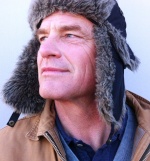
Arthur Joura- Member
 Re: American Bonsai at the NC Arboretum
Re: American Bonsai at the NC Arboretum
Thanks Arthur. Sometimes it is comforting to have a subtle transition and not be jolted by the difference. Enjoy the winter with its exposed architecture. I for one love to see the trees without the clothes.

DougB- Member
 Bonsai at the NC Arboretum
Bonsai at the NC Arboretum
Then there is Central NY. We have a few days of autumn, then winter, and a few days of spring before summer. My larches had their lovely golden dresses for about a week. I rarely get good fall color on the bonsai. Last year my Chinese elm & daphne spirea were gorgeous, this year blah.
And you wonder why I grow tropicals? My Serissa is in bloom, slightly. Several orchids in bloom to enjoy.
Iris
And you wonder why I grow tropicals? My Serissa is in bloom, slightly. Several orchids in bloom to enjoy.
Iris
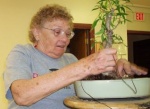
bonsaisr- Member
 Re: American Bonsai at the NC Arboretum
Re: American Bonsai at the NC Arboretum
I'm going the Saturday after thanksgiving, because I will be in the area already. Probably not the time of year to pick if I was flying there to go as my main purpose of being there. I will enjoy what is there no matter. Branch structure is fun to look at as well.
Jkd2572- Member
 First Kiss of Winter
First Kiss of Winter
Thank you Doug, Iris and Jeremy for sharing your comments.
Winter arrived this week, announcing itself with a blast of bitter temperature the other night. Then we had a long, cold rain all day yesterday, and overnight gusting winds with a dusting of snow. When I came to work this morning the Bonsai Exhibition Garden was still locked and not a soul was in sight. The bonsai are still on display, due to be put into overwintering storage next Monday. It is not a frequent sight to see snow when the garden is fully stocked with bonsai, so I took the opportunity to take many photographs and I offer this selection now for your enjoyment:







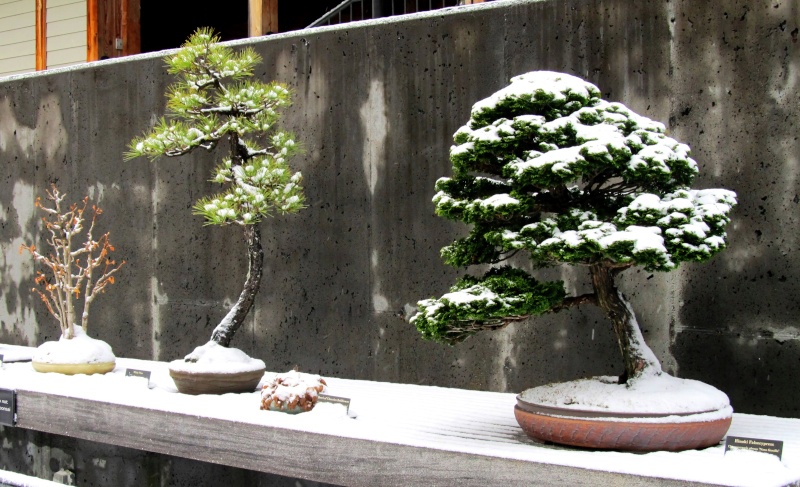









Winter arrived this week, announcing itself with a blast of bitter temperature the other night. Then we had a long, cold rain all day yesterday, and overnight gusting winds with a dusting of snow. When I came to work this morning the Bonsai Exhibition Garden was still locked and not a soul was in sight. The bonsai are still on display, due to be put into overwintering storage next Monday. It is not a frequent sight to see snow when the garden is fully stocked with bonsai, so I took the opportunity to take many photographs and I offer this selection now for your enjoyment:


















Arthur Joura- Member
 Re: American Bonsai at the NC Arboretum
Re: American Bonsai at the NC Arboretum
Beautiful Arthur!!
Thank you, brought back memories of Philadelphia and Florence [ Italy ].
Today, it is all day rain and high 70's deg.F.
Love it.
Painting and living the good life.
Looing forward to Jan.2nd when I start to repot.
Later.
Khaimraj
Thank you, brought back memories of Philadelphia and Florence [ Italy ].
Today, it is all day rain and high 70's deg.F.
Love it.
Painting and living the good life.
Looing forward to Jan.2nd when I start to repot.
Later.
Khaimraj

Khaimraj Seepersad- Member
 Winter Silhouette Display
Winter Silhouette Display
Thank you Khaimraj, for continuing to read and comment!
This past Friday I had the pleasure of showing some of the NC Arboretum's bonsai at the first ever "Winter Silhouette Exhibition" held in Kannapolis, NC. This enjoyable event was organized by Dr. Steven Zeisel, a member of the Triangle Bonsai Society in Raleigh, NC, and was held at the North Carolina Research Campus, where Steve works. The building in which the event was staged is most impressive, and I cannot remember ever being in a nicer venue for a bonsai show. It is not my purpose in this post to give a report on the Winter Silhouette Exhibition itself (Bill Valavanis, guest artist at the event, has a detailed account of the weekend with many photographs on his blog: http://valavanisbonsaiblog.com/). Rather, I want to share with you the display I made for the Arboretum's trees.
Creating formal bonsai displays is an enjoyable activity, and one in which I have an active, albeit too seldom exercised, interest. I used to make an extensive formal display every year for the Carolina Bonsai Expo, up until 2005 when the Arboretum opened the Bonsai Exhibition Garden (I posted on the IBC in some detail about this several years ago, which can be seen here: https://ibonsaiclub.forumotion.com/t4440p45-carolina-bonsai-expo-2010-pictures#45973). When the invitation came for the Arboretum to provide a display for the Winter Silhouette Exhibition, I was eager to participate. The format was basic: an 8-foot (2.43 m) table, covered with black cloth. The theme, of course, was trees in winter, with an emphasis on the beauty of bare deciduous trees.
Any time pictures from a bonsai show are posted on the IBC I am always interested to have a look. These shows are conducted all over the world so I am always looking to see how formal bonsai display is done in distant countries, or in other parts of the United States. It is always my hope to see bonsai exhibits that reflect something of the culture or region that has produced them, but I am almost always disappointed in this. The most common theme in bonsai shows, when anything is done beyond simply setting the trees out on tables, seems to be the conscious imitation of a Japanese tokonoma display featuring bonsai. Some individuals, through years of study and practice, do a fair job of producing a reasonably authentic facsimile of this look, but many more produce something much less. Sad to say, but much of the work in this vein comes off looking like a caricature-ish imitation of what it seeks to emulate.
This tendency to do bonsai display in a way that invokes the tokonoma experience is another manifestation of the overall desire on the part of a great many bonsai enthusiasts to practice bonsai as an "Ancient Japanese Art". These people enjoy bonsai as an expression of their overarching appreciation of all things Japanese, or in some cases, all things Asian. For others, who perhaps do not have this strong general attraction to Japan and Asia, it still seems to be difficult to conceive of bonsai without Asian references. So, if you are going to do a formal bonsai display and you intend to use some kind of image as part of it, the most natural item to use (and for the hardcore adherents, the only item to use) is a scroll. The table you use as a stand under your bonsai will also evince the Japanese or Asian aesthetic, and if you have a non-plant accessory item it will do the same. I see bonsai display done this way in pictures of shows from all over the western world.
Because I have no interest whatsoever in bonsai as an expression of Japanese or Asian culture, I naturally have no desire to formally display bonsai in a way that taps into that aesthetic. But the lack of that particular framework as a reference poses no problem, in my view. In fact, it frees me to think wider. It allows me to explore possibilities and experiment with different ideas, unencumbered by the notion that there are very strict guidelines about all this, or that there are only a very limited number of ways it might be correctly done.
What is the purpose of the formal bonsai display? In my thinking, it is all about creating an experience of the bonsai.
The presenter has the opportunity, and the right, to formulate that experience any way he or she chooses. If the person wants to revel in the rich, deep heritage of traditional tokonoma display, to the extent that they understand it, or simply to utilize the exotic mystique of Orientalism, they have that right, whether or not they are Asian themselves.
Likewise, if a person wants to present their bonsai in a way that has nothing at all to do with tokonoma display or Asian aesthetics, they have that right, too.
The one is not inherently better or worse than the other. There is no right way or wrong way to display bonsai, only ways that are conventional and familiar and ways that are not. Everyone who cares to do formal bonsai display has the right to go about it in their own individual manner. Everyone has the freedom to create whatever experience of bonsai they want to share with others, and then live with the results.
So, I participated in this Winter Silhouette Exhibit and involved myself in the business of creating an experience of deciduous trees in their winter aspect, working within the parameters presented by an 8-foot long table, and I approached it with a western mind that has no attraction to Asian trappings.
Here is what I came up with:

Unfortunately, I am now compelled to issue the standard lamentations about my inability to make a photograph that accurately captures the effect of seeing the display in person (Bill did a better job of it in the picture he took for his blog, but it falls short as well.) My camera is nothing special, but I can usually get out of it what I want. In these circumstances, however, the lack of a tripod, a more suitable lens and the ability to provide and manipulate supplementary lighting all undermine the ability to make a decent representation of the subject. So be it.
Having made excuses, I will now proceed to do something else I generally try to avoid, which is explain the thinking behind the display.
First, let us look at the separate components. The tree on the left side of the composition is Chinese Quince (Pseudocydonia sinensis), which I wrote about in some detail in a post back on page 2 of this thread:

I chose to use this specimen in this position because I like its overall structure and the winter viewing interest provided by the exfoliating bark. Specifically, I liked the stout, bold character of the twigs, as this tree is meant to be read as being in the foreground. It was, in fact, placed closer to the front edge of the table than was the other bonsai in the display, although only slightly so due to the spatial limitations imposed by the surface of the table upon which the entire display was arranged. The table, or stand, under the quince was made by a local woodworker out of Tuliptree (Liriodendron tulipfera) wood, which comes from a species native to eastern North America. When I had this table made years ago, my only instruction to the woodworker, beyond the dimensions I was seeking, was that he take care his design did not look Asian. The container the plant is in is Asian in origin (Japanese, I am fairly certain) but does not look overtly so, in my estimation.
The bonsai on the right side of the display features as its primary component 2 Chinese Elms (Ulmus parvifolia):

The intention when I made this bonsai landscape composition several years ago was to represent the environment of higher elevations in the Southern Appalachian mountains, where deciduous species such as oak and beech predominate and large boulders are a regular feature. The piece is used in this display to evoke that same mountain feeling, and that is why it is presented on a tall table. That part of the display is meant to be read as in the distance and higher up, and so the viewer is meant to look up at it. The finer twigging of the elm, as compared to the quince, is also meant to reinforce that sense of distance. The table was recently built by my volunteer friend Werner, and I asked him to design it to be complimentary to the other table used beneath the quince.
The third element of the display is an assemblage piece I made expressly for this exhibit:

The base of the piece is an old, weathered pine board, to which is fastened 3 components of natural origin - autumn leaves from an Oakleaf Hydrangea (Hydrangea quecifolia); empty seed pods from a Money Plant (Lunaria annua); and needles shed in autumn by a Pitch Pine (Pinus rigida). These items I collected from my home landscape only days before the show, so they are true reflections of the nature of the landscape at this time of year. That was the purpose of including the piece in this display, to reinforce the sense of seasonal identity. The piece of red material running vertically behind the assemblage piece is a table runner I borrowed off of my dining room table at home (with my good wife's perplexed but willing assent!) Here, my intent was nothing more than to introduce a splash of color to enliven the overall image presented by the display, and I thought the plant motif incorporated in the design of the table runner leant itself to the nature-related theme of the composition. The idea presented itself serendipitously one evening when I was eating dinner and looking about the room.
In an effort to give a better impression of the real life effect of the display, I did a bit of crude Photoshop reworking of the first picture I presented above:

Here I have been able to blacken-out the white marble of the walls peeking out from behind the backdrop, which was there in real life but exaggerated in the photograph. I have also changed the image of the assemblage piece, which was obliterated in the first photograph by the effect of the camera's flash. Still evident is the distorting effect the camera lens has on perspective, most noticeable in the perspective given to the 2 display tables. Without any doubt, the appearance of things seen in person and the same things seen in photographic images is distinctly different, and this phenomenon can have both positive and negative implications. In my experience, bonsai displays photographed casually and without benefit of proper equipment skillfully employed invariably results in a poor representation. In short, you should have been there!
The Arboretum had a second display at this exhibition, and I should not neglect to mention it here because it won an award:

This of course is the "Yoshimura Island" planting of American Hornbeam (Carpinus caroliniana), which I previously wrote about in this thread back on page 4. This display was an afterthought, a late addition to the show, and all it amounted to was presenting the piece by itself on the 8-foot table, resting on a few pieces of wood hidden underneath so as to give the "island" the appearance of floating a couple of inches above the table surface. The background is the naturally sumptuous appearance of the Italian white marble that adorned the walls in the magnificent display area. It turned out that bare deciduous trees presented very well off of this surface.
Bill Valavanis selected this display as the recipient of the award for Best Winter Silhouette, which at a Winter Silhouette Exhibition is not a bad award to win! The Arboretum was suitably honored by this as there were numerous other excellent candidates in the show. Although Bill's vast bonsai experience and expertise is not to be trifled with, I cannot help but wonder if the Yuji Yoshimura connection enjoyed by this particular specimen did not in some way influence his decision.
Here, to close, is a picture of the "Yoshimura Island" planting proudly wearing its 1st place ribbon:

Many thanks to Dr. Steven Zeisel for organizing this fine event, and to the North Carolina Research Campus for hosting it. I am pleased to say planning is already underway to have the Winter Silhouette Exhibition become an annual event.
This past Friday I had the pleasure of showing some of the NC Arboretum's bonsai at the first ever "Winter Silhouette Exhibition" held in Kannapolis, NC. This enjoyable event was organized by Dr. Steven Zeisel, a member of the Triangle Bonsai Society in Raleigh, NC, and was held at the North Carolina Research Campus, where Steve works. The building in which the event was staged is most impressive, and I cannot remember ever being in a nicer venue for a bonsai show. It is not my purpose in this post to give a report on the Winter Silhouette Exhibition itself (Bill Valavanis, guest artist at the event, has a detailed account of the weekend with many photographs on his blog: http://valavanisbonsaiblog.com/). Rather, I want to share with you the display I made for the Arboretum's trees.
Creating formal bonsai displays is an enjoyable activity, and one in which I have an active, albeit too seldom exercised, interest. I used to make an extensive formal display every year for the Carolina Bonsai Expo, up until 2005 when the Arboretum opened the Bonsai Exhibition Garden (I posted on the IBC in some detail about this several years ago, which can be seen here: https://ibonsaiclub.forumotion.com/t4440p45-carolina-bonsai-expo-2010-pictures#45973). When the invitation came for the Arboretum to provide a display for the Winter Silhouette Exhibition, I was eager to participate. The format was basic: an 8-foot (2.43 m) table, covered with black cloth. The theme, of course, was trees in winter, with an emphasis on the beauty of bare deciduous trees.
Any time pictures from a bonsai show are posted on the IBC I am always interested to have a look. These shows are conducted all over the world so I am always looking to see how formal bonsai display is done in distant countries, or in other parts of the United States. It is always my hope to see bonsai exhibits that reflect something of the culture or region that has produced them, but I am almost always disappointed in this. The most common theme in bonsai shows, when anything is done beyond simply setting the trees out on tables, seems to be the conscious imitation of a Japanese tokonoma display featuring bonsai. Some individuals, through years of study and practice, do a fair job of producing a reasonably authentic facsimile of this look, but many more produce something much less. Sad to say, but much of the work in this vein comes off looking like a caricature-ish imitation of what it seeks to emulate.
This tendency to do bonsai display in a way that invokes the tokonoma experience is another manifestation of the overall desire on the part of a great many bonsai enthusiasts to practice bonsai as an "Ancient Japanese Art". These people enjoy bonsai as an expression of their overarching appreciation of all things Japanese, or in some cases, all things Asian. For others, who perhaps do not have this strong general attraction to Japan and Asia, it still seems to be difficult to conceive of bonsai without Asian references. So, if you are going to do a formal bonsai display and you intend to use some kind of image as part of it, the most natural item to use (and for the hardcore adherents, the only item to use) is a scroll. The table you use as a stand under your bonsai will also evince the Japanese or Asian aesthetic, and if you have a non-plant accessory item it will do the same. I see bonsai display done this way in pictures of shows from all over the western world.
Because I have no interest whatsoever in bonsai as an expression of Japanese or Asian culture, I naturally have no desire to formally display bonsai in a way that taps into that aesthetic. But the lack of that particular framework as a reference poses no problem, in my view. In fact, it frees me to think wider. It allows me to explore possibilities and experiment with different ideas, unencumbered by the notion that there are very strict guidelines about all this, or that there are only a very limited number of ways it might be correctly done.
What is the purpose of the formal bonsai display? In my thinking, it is all about creating an experience of the bonsai.
The presenter has the opportunity, and the right, to formulate that experience any way he or she chooses. If the person wants to revel in the rich, deep heritage of traditional tokonoma display, to the extent that they understand it, or simply to utilize the exotic mystique of Orientalism, they have that right, whether or not they are Asian themselves.
Likewise, if a person wants to present their bonsai in a way that has nothing at all to do with tokonoma display or Asian aesthetics, they have that right, too.
The one is not inherently better or worse than the other. There is no right way or wrong way to display bonsai, only ways that are conventional and familiar and ways that are not. Everyone who cares to do formal bonsai display has the right to go about it in their own individual manner. Everyone has the freedom to create whatever experience of bonsai they want to share with others, and then live with the results.
So, I participated in this Winter Silhouette Exhibit and involved myself in the business of creating an experience of deciduous trees in their winter aspect, working within the parameters presented by an 8-foot long table, and I approached it with a western mind that has no attraction to Asian trappings.
Here is what I came up with:

Unfortunately, I am now compelled to issue the standard lamentations about my inability to make a photograph that accurately captures the effect of seeing the display in person (Bill did a better job of it in the picture he took for his blog, but it falls short as well.) My camera is nothing special, but I can usually get out of it what I want. In these circumstances, however, the lack of a tripod, a more suitable lens and the ability to provide and manipulate supplementary lighting all undermine the ability to make a decent representation of the subject. So be it.
Having made excuses, I will now proceed to do something else I generally try to avoid, which is explain the thinking behind the display.
First, let us look at the separate components. The tree on the left side of the composition is Chinese Quince (Pseudocydonia sinensis), which I wrote about in some detail in a post back on page 2 of this thread:

I chose to use this specimen in this position because I like its overall structure and the winter viewing interest provided by the exfoliating bark. Specifically, I liked the stout, bold character of the twigs, as this tree is meant to be read as being in the foreground. It was, in fact, placed closer to the front edge of the table than was the other bonsai in the display, although only slightly so due to the spatial limitations imposed by the surface of the table upon which the entire display was arranged. The table, or stand, under the quince was made by a local woodworker out of Tuliptree (Liriodendron tulipfera) wood, which comes from a species native to eastern North America. When I had this table made years ago, my only instruction to the woodworker, beyond the dimensions I was seeking, was that he take care his design did not look Asian. The container the plant is in is Asian in origin (Japanese, I am fairly certain) but does not look overtly so, in my estimation.
The bonsai on the right side of the display features as its primary component 2 Chinese Elms (Ulmus parvifolia):

The intention when I made this bonsai landscape composition several years ago was to represent the environment of higher elevations in the Southern Appalachian mountains, where deciduous species such as oak and beech predominate and large boulders are a regular feature. The piece is used in this display to evoke that same mountain feeling, and that is why it is presented on a tall table. That part of the display is meant to be read as in the distance and higher up, and so the viewer is meant to look up at it. The finer twigging of the elm, as compared to the quince, is also meant to reinforce that sense of distance. The table was recently built by my volunteer friend Werner, and I asked him to design it to be complimentary to the other table used beneath the quince.
The third element of the display is an assemblage piece I made expressly for this exhibit:

The base of the piece is an old, weathered pine board, to which is fastened 3 components of natural origin - autumn leaves from an Oakleaf Hydrangea (Hydrangea quecifolia); empty seed pods from a Money Plant (Lunaria annua); and needles shed in autumn by a Pitch Pine (Pinus rigida). These items I collected from my home landscape only days before the show, so they are true reflections of the nature of the landscape at this time of year. That was the purpose of including the piece in this display, to reinforce the sense of seasonal identity. The piece of red material running vertically behind the assemblage piece is a table runner I borrowed off of my dining room table at home (with my good wife's perplexed but willing assent!) Here, my intent was nothing more than to introduce a splash of color to enliven the overall image presented by the display, and I thought the plant motif incorporated in the design of the table runner leant itself to the nature-related theme of the composition. The idea presented itself serendipitously one evening when I was eating dinner and looking about the room.
In an effort to give a better impression of the real life effect of the display, I did a bit of crude Photoshop reworking of the first picture I presented above:

Here I have been able to blacken-out the white marble of the walls peeking out from behind the backdrop, which was there in real life but exaggerated in the photograph. I have also changed the image of the assemblage piece, which was obliterated in the first photograph by the effect of the camera's flash. Still evident is the distorting effect the camera lens has on perspective, most noticeable in the perspective given to the 2 display tables. Without any doubt, the appearance of things seen in person and the same things seen in photographic images is distinctly different, and this phenomenon can have both positive and negative implications. In my experience, bonsai displays photographed casually and without benefit of proper equipment skillfully employed invariably results in a poor representation. In short, you should have been there!
The Arboretum had a second display at this exhibition, and I should not neglect to mention it here because it won an award:

This of course is the "Yoshimura Island" planting of American Hornbeam (Carpinus caroliniana), which I previously wrote about in this thread back on page 4. This display was an afterthought, a late addition to the show, and all it amounted to was presenting the piece by itself on the 8-foot table, resting on a few pieces of wood hidden underneath so as to give the "island" the appearance of floating a couple of inches above the table surface. The background is the naturally sumptuous appearance of the Italian white marble that adorned the walls in the magnificent display area. It turned out that bare deciduous trees presented very well off of this surface.
Bill Valavanis selected this display as the recipient of the award for Best Winter Silhouette, which at a Winter Silhouette Exhibition is not a bad award to win! The Arboretum was suitably honored by this as there were numerous other excellent candidates in the show. Although Bill's vast bonsai experience and expertise is not to be trifled with, I cannot help but wonder if the Yuji Yoshimura connection enjoyed by this particular specimen did not in some way influence his decision.
Here, to close, is a picture of the "Yoshimura Island" planting proudly wearing its 1st place ribbon:

Many thanks to Dr. Steven Zeisel for organizing this fine event, and to the North Carolina Research Campus for hosting it. I am pleased to say planning is already underway to have the Winter Silhouette Exhibition become an annual event.

Arthur Joura- Member
 Re: American Bonsai at the NC Arboretum
Re: American Bonsai at the NC Arboretum
I had hoped to make it to this show for many reasons, but health (and other) things got in my way. I do hope it becomes an annual event. Next, someone needs to start up a spring/early summer show.
I agree. Wholeheartedly. There may be no one who is more oriented toward, and a fan of, Japanese arts than I am (I spend much too much $$$ on netsuke and Ukiyoe, for instance), but I am NOT Japanese and have no desire, really, to pretend that I am. Still, if we are to separate ourselves from the Japan-ness of what we do, we probably need to call what we do and what we create something other than "bonsai." Don't ask me what.
Please keep these essays coming, Arthur, and I really do like your display and wish I could have been there to see it "in the flesh."
This tendency to do bonsai display in a way that invokes the tokonoma experience is another manifestation of the overall desire on the part of a great many bonsai enthusiasts to practice bonsai as an "Ancient Japanese Art". These people enjoy bonsai as an expression of their overarching appreciation of all things Japanese, or in some cases, all things Asian. For others, who perhaps do not have this strong general attraction to Japan and Asia, it still seems to be difficult to conceive of bonsai without Asian references. So, if you are going to do a formal bonsai display and you intend to use some kind of image as part of it, the most natural item to use (and for the hardcore adherents, the only item to use) is a scroll. The table you use as a stand under your bonsai will also evince the Japanese or Asian aesthetic, and if you have a non-plant accessory item it will do the same. I see bonsai display done this way in pictures of shows from all over the western world.
Because I have no interest whatsoever in bonsai as an expression of Japanese or Asian culture, I naturally have no desire to formally display bonsai in a way that taps into that aesthetic. But the lack of that particular framework as a reference poses no problem, in my view.
I agree. Wholeheartedly. There may be no one who is more oriented toward, and a fan of, Japanese arts than I am (I spend much too much $$$ on netsuke and Ukiyoe, for instance), but I am NOT Japanese and have no desire, really, to pretend that I am. Still, if we are to separate ourselves from the Japan-ness of what we do, we probably need to call what we do and what we create something other than "bonsai." Don't ask me what.
Please keep these essays coming, Arthur, and I really do like your display and wish I could have been there to see it "in the flesh."

JimLewis- Member
 Re: American Bonsai at the NC Arboretum
Re: American Bonsai at the NC Arboretum
Arthur,
This thread is becoming an incredible source of inspiration, I enjoy and savor each post.
Cheers Graham
This thread is becoming an incredible source of inspiration, I enjoy and savor each post.
Cheers Graham
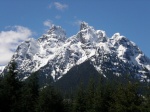
gman- Member
 I Do Bonsai
I Do Bonsai
Graham - Thank you for the very kind words! Knowing there are people who care about what I am posting makes maintaining this thread worthwhile.
Jim - as always, I appreciate you reading and commenting, as you consistently do.
I want to respond directly to one part of what you wrote, in which you muse that it might be desirable for people who want to be free of the persistent idea that bonsai must be identified with Japan to find another name by which to call what they do. In other words, to use the term "bonsai" strictly for that which is done in the Japanese style. Everyone else who cultivates miniaturized trees in containers or on slabs would call what they do by some other name.
At one time I could see some merit in this idea. At first, the problem seemed to be one of practicality - what else might one call it? Minitrees? Sculpted Containerized Plants (SCP's for short)? How about we borrow the title of Mr. Wu's famous Penjing book - "Artistic Pot Plants"? Calling them that might result in a temporary spike in public interest, until people found out it does not mean what they thought it meant. Eventually I decided the likely outcome of using a different name would be more confusion and the subsequent need for more explanation.
Then, the more I thought about it the more irritated I became at the notion of having to call what I do by some name other than bonsai. I checked to see if the Nippon Bonsai Association has trademarked the term "bonsai" and it seems they have not. I checked to see if there are any laws that mandate a person doing bonsai must do it a certain way in order to have the right to call what they do "bonsai", and, surprisingly, there are not.
So this idea that bonsai is a Japanese art (as it is so often defined) is nothing more than a convention of thought. People think that way because they have been told over and over that it is so. Thinking that bonsai is Japanese is simply a habit, and habits can be changed.
Moreover, if bonsai is truly an art, it too has to change, because no art form I can think of is static. For that matter, no art form I can think of is the property of a nation, with that nation having the sole right to dictate how it should be done. The more I think of it, the more preposterous that whole idea becomes.
Art is a human construct, like freedom, and the two go hand in hand.
If bonsai is to be considered an art, people must be free to constantly overturn the existing conventions and find new ways of doing. I will keep calling what I do "bonsai". Perhaps the people who insist on limiting the concept of what bonsai can be should start referring to what they do by some other name?
Jim - as always, I appreciate you reading and commenting, as you consistently do.
I want to respond directly to one part of what you wrote, in which you muse that it might be desirable for people who want to be free of the persistent idea that bonsai must be identified with Japan to find another name by which to call what they do. In other words, to use the term "bonsai" strictly for that which is done in the Japanese style. Everyone else who cultivates miniaturized trees in containers or on slabs would call what they do by some other name.
At one time I could see some merit in this idea. At first, the problem seemed to be one of practicality - what else might one call it? Minitrees? Sculpted Containerized Plants (SCP's for short)? How about we borrow the title of Mr. Wu's famous Penjing book - "Artistic Pot Plants"? Calling them that might result in a temporary spike in public interest, until people found out it does not mean what they thought it meant. Eventually I decided the likely outcome of using a different name would be more confusion and the subsequent need for more explanation.
Then, the more I thought about it the more irritated I became at the notion of having to call what I do by some name other than bonsai. I checked to see if the Nippon Bonsai Association has trademarked the term "bonsai" and it seems they have not. I checked to see if there are any laws that mandate a person doing bonsai must do it a certain way in order to have the right to call what they do "bonsai", and, surprisingly, there are not.
So this idea that bonsai is a Japanese art (as it is so often defined) is nothing more than a convention of thought. People think that way because they have been told over and over that it is so. Thinking that bonsai is Japanese is simply a habit, and habits can be changed.
Moreover, if bonsai is truly an art, it too has to change, because no art form I can think of is static. For that matter, no art form I can think of is the property of a nation, with that nation having the sole right to dictate how it should be done. The more I think of it, the more preposterous that whole idea becomes.
Art is a human construct, like freedom, and the two go hand in hand.
If bonsai is to be considered an art, people must be free to constantly overturn the existing conventions and find new ways of doing. I will keep calling what I do "bonsai". Perhaps the people who insist on limiting the concept of what bonsai can be should start referring to what they do by some other name?

Arthur Joura- Member
 Re: American Bonsai at the NC Arboretum
Re: American Bonsai at the NC Arboretum
I went the day Saturday after thanksgiving to the arboretum. The trees and the exhibit were awesome. 22 degrees when I arrived that morning. My wife was a trooper as I showed her trees. Thanks for bringing this to the public. My absolute favorite was the crepe myrtle. Fantastic tree. The cypress forest fell in 2nd.
Jkd2572- Member
 Re: American Bonsai at the NC Arboretum
Re: American Bonsai at the NC Arboretum
Thanks for letting us get a glimpse into your though processes -- they are interesting and enlightening. (And of great value.) BUT Arthur after I have pondered over your comments -- my brain hurts.
Thanks and have a blessed Christmas
Thanks and have a blessed Christmas

DougB- Member
 Re: American Bonsai at the NC Arboretum
Re: American Bonsai at the NC Arboretum
I always look forward to seeing your updates on this blog like thread. It's beautifully done. Thank you.
I do not understand why we would choose to distance ourselves from the word bonsai. I don't feel that traditional Japanese display, or even styling is imperative. It is widely accepted as the standard, but I'm not sure that is necessary. However, this art form came to us from another culture, and I don't know why we wouldn't want to respect the roots of this discipline. By attempting to re-name it, would you be trying to claim ownership of the origins? A rose is still a rose.....
Not trying to be argumentative here, just discussion.
I do not understand why we would choose to distance ourselves from the word bonsai. I don't feel that traditional Japanese display, or even styling is imperative. It is widely accepted as the standard, but I'm not sure that is necessary. However, this art form came to us from another culture, and I don't know why we wouldn't want to respect the roots of this discipline. By attempting to re-name it, would you be trying to claim ownership of the origins? A rose is still a rose.....
Not trying to be argumentative here, just discussion.
JudyB- Member
 Re: American Bonsai at the NC Arboretum
Re: American Bonsai at the NC Arboretum
Just my observation from study:
When the Japanese adapted and changed the art of potted trees from the Chinese they changed the name of potted trees to the word "bonsai" to reflect the philosophy taste and style of the Japanese people. There are numerous parameters to bonsai as established by the Japanese. Many do not accept, nor respect these parameters and try to change them. But, they can't change the trees without changing the name. As you know there are vast differences between what you see in China compared to what you see in Japan.
In the horticultural manual "Senkao-den" published in 1851, the Japanese first established the change in the pronunciation of the word "Bonsai" from the original "Hauchi-ue" which means potted tree.
The Japanese also did the same thing when they adapted the art of stone appreciation from the Chinese. They named their art suiseki, which has definite parameters, much different than the original (?) Chinese appreciation. As can be easily seen there is a big difference between the Chinese and Japanese taste for stones.
I think the Japanese also liked American baseball and have now adapted it. I don't know too much about baseball, but I believe what the Japanese do is similar to what the Americans play. So, did the Japanese change the name, no, because they did not change the rules.
All I'm trying to say is that it is fine and should be encouraged to grow and appreciate bonsai according to your own taste and culture. BUT if you vary from what the Japanese practice, it might be a good idea to rename what you are doing from bonsai to another word, "Potted Tree?"
There are strict guidelines to Japanese bonsai and Japanese suiseki. There is no problem to express your own philosophy, guidelines and taste, but then you should not correctly use the words bonsai and suiseki.
Most of the world embraced and learned the art of potted trees from Japanese in the own style they call bonsai, but this is not the real origin. So what people are really doing is changing the art of growing and appreciating the art of potted trees.
Just my thoughts this morning...
Bill
PS: By the way, the word "Saikei" is a registered trademark of Toshio Kawamoto.
When the Japanese adapted and changed the art of potted trees from the Chinese they changed the name of potted trees to the word "bonsai" to reflect the philosophy taste and style of the Japanese people. There are numerous parameters to bonsai as established by the Japanese. Many do not accept, nor respect these parameters and try to change them. But, they can't change the trees without changing the name. As you know there are vast differences between what you see in China compared to what you see in Japan.
In the horticultural manual "Senkao-den" published in 1851, the Japanese first established the change in the pronunciation of the word "Bonsai" from the original "Hauchi-ue" which means potted tree.
The Japanese also did the same thing when they adapted the art of stone appreciation from the Chinese. They named their art suiseki, which has definite parameters, much different than the original (?) Chinese appreciation. As can be easily seen there is a big difference between the Chinese and Japanese taste for stones.
I think the Japanese also liked American baseball and have now adapted it. I don't know too much about baseball, but I believe what the Japanese do is similar to what the Americans play. So, did the Japanese change the name, no, because they did not change the rules.
All I'm trying to say is that it is fine and should be encouraged to grow and appreciate bonsai according to your own taste and culture. BUT if you vary from what the Japanese practice, it might be a good idea to rename what you are doing from bonsai to another word, "Potted Tree?"
There are strict guidelines to Japanese bonsai and Japanese suiseki. There is no problem to express your own philosophy, guidelines and taste, but then you should not correctly use the words bonsai and suiseki.
Most of the world embraced and learned the art of potted trees from Japanese in the own style they call bonsai, but this is not the real origin. So what people are really doing is changing the art of growing and appreciating the art of potted trees.
Just my thoughts this morning...
Bill
PS: By the way, the word "Saikei" is a registered trademark of Toshio Kawamoto.
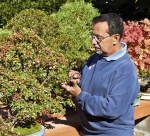
William N. Valavanis- Member
 Re: American Bonsai at the NC Arboretum
Re: American Bonsai at the NC Arboretum
Group, I made an error about the origin of the pronunciation of the word bonsai. I misread Yoshimura's article.
In the 1851 book the author gave instructions to pronounce the Chinese characters we call "bonsai" as "Hauchi-ue", which means Potted Tree.
Sorry about that!
But I still maintain that the form of bonsai that most of us enjoy and are familiar with is a Japanese art and if you want to deviate from it the word bonsai should not be utilized.
Bill
In the 1851 book the author gave instructions to pronounce the Chinese characters we call "bonsai" as "Hauchi-ue", which means Potted Tree.
Sorry about that!
But I still maintain that the form of bonsai that most of us enjoy and are familiar with is a Japanese art and if you want to deviate from it the word bonsai should not be utilized.
Bill

William N. Valavanis- Member
 Re: American Bonsai at the NC Arboretum
Re: American Bonsai at the NC Arboretum
Thank you all for this discussion – very interesting and very illuminating. And many thanks to Arthur Joura for these posts. I have not been on IBC for quite a while given external circumstances but I truly enjoyed reading through and catching up on this series of posts! Thanks again for sharing – these have been interesting and illuminating!
I have a few observations on this most recent exchange which may be of interest to some, or perhaps just of interest to me… (if the latter, my apologies!)
Language and word meaning is a matter of common usage. Words and associated meanings that are used frequently gain acceptance while words and associated meanings that fall from common favor lose acceptance and fall from usage (i.e. they become lexicographical footnotes). Some cultures and communities attempt to moderate the natural and cultural processes which control word usage, other are laissez-faire – but ultimately word usage and associated meaning shift over time to accommodate ideas which might have been inconceivable or incomprehensible at the time the word itself was first coined.
I have no great concern about the use of the word “bonsai” nor its associated meaning except that it convey to those with whom I am trying to exchange information a basic, if imperfectly, shared set of ideas.
I spent many years delving into the realms of plant taxonomy. The primary purpose of this pursuit is to communicate to another individual a very precise set of understandings regarding the morphology, phylogeny, evolutionary relationships, etc. of a particular subset of plants. It is an effective system – however it requires detailed knowledge of both historical and current usages of any and all terms used in the particular taxonomic description. This is no small task! We have seen many exchanges on this forum with regard to how a particular taxonomy may have changed over time – some insisting that the new is correct, others entrenched that the historical interpretation is best. Yet plant taxonomy is a system governed by rigorous rules and structures to facilitate analysis and resolution of disagreements with regard to meaning and usage. In common word usage – regardless of language – no such structures exist (well – I should caveat no such effective structures exist.)
For me, I am happy to have the common understanding of the word “bonsai” be a small tree in a pot. In many “commoners” it may conger images of “tree torture”, or “tree bondage”, or even (if lucky) “tree art” – however; I think if we look beyond bonsai insiders we will not find a notion of “this is Japanese style” for something labeled “bonsai” whereas “this is Chinese style” for something else labels “penjing” (sorry if I got my term wrong, I am no expert in this!)
If it seems prudent for bonsai-insiders to develop a taxonomy of our art based of the county of origin and/or the traditions associated with our artistic influences then so be it. However, I caution that any effort extended to establish such a taxonomy may not (and probably will not) become part of standard usage. All I need point to is the paucity of taxonomic nomenclature in this forum with regard to tree identification and the abundance of common usage terms.
Sorry for the diatribe, if you took it as such. These are simply things I have spent time thinking about, so I thought that perhaps a few might like to hear an echo of such thoughts.
For me “bonsai” works just fine. If I am speaking to a knowledgeable person I can easily add “bonsai in the Japanese style”, “bonsai in the naturalistic style”, or “bonsai in my style”. Does the word “bonsai” as a standalone convey in the common usage across many languages a “Japanese” feel? Yes, I believe so. However, that too will change over time, as all things do: and I don’t think it’s such a bad start.
Thank you all for your indulgence – and it is great to be reading all your posts again!
David Brunner
I have a few observations on this most recent exchange which may be of interest to some, or perhaps just of interest to me… (if the latter, my apologies!)
Language and word meaning is a matter of common usage. Words and associated meanings that are used frequently gain acceptance while words and associated meanings that fall from common favor lose acceptance and fall from usage (i.e. they become lexicographical footnotes). Some cultures and communities attempt to moderate the natural and cultural processes which control word usage, other are laissez-faire – but ultimately word usage and associated meaning shift over time to accommodate ideas which might have been inconceivable or incomprehensible at the time the word itself was first coined.
I have no great concern about the use of the word “bonsai” nor its associated meaning except that it convey to those with whom I am trying to exchange information a basic, if imperfectly, shared set of ideas.
I spent many years delving into the realms of plant taxonomy. The primary purpose of this pursuit is to communicate to another individual a very precise set of understandings regarding the morphology, phylogeny, evolutionary relationships, etc. of a particular subset of plants. It is an effective system – however it requires detailed knowledge of both historical and current usages of any and all terms used in the particular taxonomic description. This is no small task! We have seen many exchanges on this forum with regard to how a particular taxonomy may have changed over time – some insisting that the new is correct, others entrenched that the historical interpretation is best. Yet plant taxonomy is a system governed by rigorous rules and structures to facilitate analysis and resolution of disagreements with regard to meaning and usage. In common word usage – regardless of language – no such structures exist (well – I should caveat no such effective structures exist.)
For me, I am happy to have the common understanding of the word “bonsai” be a small tree in a pot. In many “commoners” it may conger images of “tree torture”, or “tree bondage”, or even (if lucky) “tree art” – however; I think if we look beyond bonsai insiders we will not find a notion of “this is Japanese style” for something labeled “bonsai” whereas “this is Chinese style” for something else labels “penjing” (sorry if I got my term wrong, I am no expert in this!)
If it seems prudent for bonsai-insiders to develop a taxonomy of our art based of the county of origin and/or the traditions associated with our artistic influences then so be it. However, I caution that any effort extended to establish such a taxonomy may not (and probably will not) become part of standard usage. All I need point to is the paucity of taxonomic nomenclature in this forum with regard to tree identification and the abundance of common usage terms.
Sorry for the diatribe, if you took it as such. These are simply things I have spent time thinking about, so I thought that perhaps a few might like to hear an echo of such thoughts.
For me “bonsai” works just fine. If I am speaking to a knowledgeable person I can easily add “bonsai in the Japanese style”, “bonsai in the naturalistic style”, or “bonsai in my style”. Does the word “bonsai” as a standalone convey in the common usage across many languages a “Japanese” feel? Yes, I believe so. However, that too will change over time, as all things do: and I don’t think it’s such a bad start.
Thank you all for your indulgence – and it is great to be reading all your posts again!
David Brunner
David Brunner- Member
 Re: Bonsai at the NC Arboretum
Re: Bonsai at the NC Arboretum
Arthur,
Many thanks for the continuous and detailed posting on this thread. A valuable educational experience -- whether it be the pest management series, Dr. Creech and Robert Drechsler involvements, Yuji Yoshimura's island, Werner's display stand development, or your collection with snow.
The closeup of the Rocky Mountain Juniper, in particular, keeps drawing me back, https://servimg.com/view/15975054/227 .
(I was also able to add a few more specimens to my ongoing grand listing, http://www.phoenixbonsai.com/BigPicture/BPARosid.html , from your many photos' captions.)
We look forward to additional updates and insights. Some day I hope to see the collection in person and talk with you directly.
Thank-you, sir!
Many thanks for the continuous and detailed posting on this thread. A valuable educational experience -- whether it be the pest management series, Dr. Creech and Robert Drechsler involvements, Yuji Yoshimura's island, Werner's display stand development, or your collection with snow.
The closeup of the Rocky Mountain Juniper, in particular, keeps drawing me back, https://servimg.com/view/15975054/227 .
(I was also able to add a few more specimens to my ongoing grand listing, http://www.phoenixbonsai.com/BigPicture/BPARosid.html , from your many photos' captions.)
We look forward to additional updates and insights. Some day I hope to see the collection in person and talk with you directly.
Thank-you, sir!

Robert J. Baran- Member
 Re: American Bonsai at the NC Arboretum
Re: American Bonsai at the NC Arboretum
Yes, David. You were missed. You left Iris as the only taxonomical "expert" here; I'm sure she's happy, too. <g> Look forward to hearing from you more in the future.
Guess I'll give up any attempt to call our little trees something else.
Guess I'll give up any attempt to call our little trees something else.

JimLewis- Member
 Re: American Bonsai at the NC Arboretum
Re: American Bonsai at the NC Arboretum
I think of the term "Bonsai" much in the same way I think of the term "food". There are many types of food with cultural overtones that expand on the basic term (Chinese food, Japanese food, American food, etc....) Some I like and some I wouldn't touch!. To think there is only one kind of bonsai is like saying there's only one kind of food, oh what a bore that would be!

Randy_Davis- Member
 Re: American Bonsai at the NC Arboretum
Re: American Bonsai at the NC Arboretum
Thank you very much Arthur, for the incredible series of posts here. As mentioned before, this is like a blog on the forum; and It's incredibly enjoyable to follow. (Also, thank you for your permission to use your pest control writings for our club.)
I just caught up on the reading. Great pictures, great writing and overall I appreciate your attitude toward bonsai, nature and life in general. You effectively communicate the joy of bonsai through this thread. Keep it up!
---------------------------------------------------------------------------------------------------
On the discussion about the usage of the term "Bonsai'... Not all "bonsai" are even in pots. Some are on slabs or rocks, yet they still fall under the umbrella of bonsai. Or am I mistaken? -- (My teacher, chooses to display some of his trees entirely free of a pot. He is classically trained by a Japanese master, but he still chooses to make some creations that stray from tradition. Does this exclude a tree from being judged in a bonsai show? If the tree is in every way a bonsai (and a very good one I might add), only it's not in a traditional pot, does that mean a person must disassociate it from "bonsai"?
I think I'll agree with the above post and say that words are simply terms we use to try and describe life. In all reality, they (words) are insufficient, helpful, yet insufficient. I'd rather experience these wonderful little trees than get hung up on trying to fit them into my box of terms and understandings of terms. I'll say that no matter what I create with these little trees they will always be influenced to some degree by those that we inherited the art form from, and if someday someone decides to call my creations by a different name... so be it; I don't think it really matters that much. Language is a tool we use to communicate... so is art.
I just caught up on the reading. Great pictures, great writing and overall I appreciate your attitude toward bonsai, nature and life in general. You effectively communicate the joy of bonsai through this thread. Keep it up!
---------------------------------------------------------------------------------------------------
On the discussion about the usage of the term "Bonsai'... Not all "bonsai" are even in pots. Some are on slabs or rocks, yet they still fall under the umbrella of bonsai. Or am I mistaken? -- (My teacher, chooses to display some of his trees entirely free of a pot. He is classically trained by a Japanese master, but he still chooses to make some creations that stray from tradition. Does this exclude a tree from being judged in a bonsai show? If the tree is in every way a bonsai (and a very good one I might add), only it's not in a traditional pot, does that mean a person must disassociate it from "bonsai"?
I think I'll agree with the above post and say that words are simply terms we use to try and describe life. In all reality, they (words) are insufficient, helpful, yet insufficient. I'd rather experience these wonderful little trees than get hung up on trying to fit them into my box of terms and understandings of terms. I'll say that no matter what I create with these little trees they will always be influenced to some degree by those that we inherited the art form from, and if someday someone decides to call my creations by a different name... so be it; I don't think it really matters that much. Language is a tool we use to communicate... so is art.

Dan W.- Member
Page 5 of 40 •  1, 2, 3, 4, 5, 6 ... 22 ... 40
1, 2, 3, 4, 5, 6 ... 22 ... 40 
 Similar topics
Similar topics» American Bonsai at the NC Arboretum
» WISTERIA BONSAI AT INTERNATIONAL BONSAI ARBORETUM
» Ashville arboretum bonsai
» Carolina Bonsai Expo @ NC Arboretum
» Autumn at the NC Arboretum bonsai garden
» WISTERIA BONSAI AT INTERNATIONAL BONSAI ARBORETUM
» Ashville arboretum bonsai
» Carolina Bonsai Expo @ NC Arboretum
» Autumn at the NC Arboretum bonsai garden
Page 5 of 40
Permissions in this forum:
You cannot reply to topics in this forum






